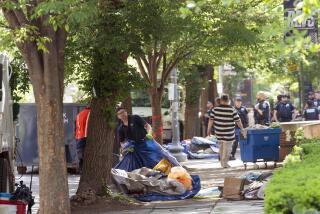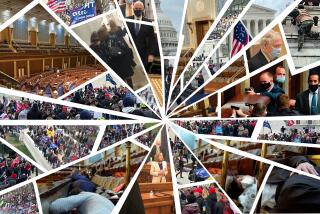Some Angry Residents Join in as Marches Move From Downtown
- Share via
SEATTLE — Responding to outraged residents who poured into the streets after fighting off tear gas in their neighborhood, Seattle officials Thursday eased the state of emergency that has paralyzed the inner city--allowing at least two protest marches and scaling back the columns of riot police that have blockaded downtown intersections.
“We need to put an end to this. We need to talk,” Mayor Paul Schell said wearily after a police crackdown against World Trade Organization protesters prompted the backlash in which hundreds of residents came out of their homes and faced off against police.
After a night of confrontations that left some residents of the Capitol Hill neighborhood crouching on the floors of their homes, city leaders faced a barrage of angry criticism Thursday morning. Schell--facing a city as distraught about the police crackdown as over the WTO protesters who have dominated the streets--pledged to “start the healing process.”
“Our primary goal is to regain and maintain peace in our city,” the mayor said. “But we are still in a state of emergency. This is not business as usual. People must understand that.”
A 7 p.m. to 7:30 a.m. curfew went into effect for the third straight night Thursday, but police dramatically scaled back their tactics, if not their numbers. A day after marching through rush-hour traffic--armed with billy clubs and hurling tear gas at protesters in the city’s famous Pike Place Market--police on Thursday issued a permit for one downtown rally and provided a motorcycle escort for illegal demonstrators marching from Capitol Hill to the downtown jail.
Hundreds of protesters surrounded the jail throughout the day seeking the release of more than 500 who have been arrested since demonstrations began. After a long standoff, the protesters left voluntarily after the city agreed to allow legal advisors into the jail to meet with the detainees.
Schell shrank the police perimeter around the WTO talks and said he would consider reducing the bounds of the curfew zone--which now extends over the entire downtown area--and would open a dialogue with protest leaders to make room for peaceful demonstrations and marches.
Curfew Moves Protest to Nearby Community
The turning point came in the predawn hours Thursday, when an eclectic neighborhood of artists, musicians, political activists and students came under siege until about 3 a.m.
According to police, a group of 200 to 300 WTO protesters--edged out of downtown by the curfew--moved into the streets of Capitol Hill, where they blocked two major intersections and threatened officers with rocks, bottles and Molotov cocktails. Several windows at local businesses were smashed. At least some protesters charged the police line, department spokesmen said.
Officers responded with tear gas and concussion grenades, finally deploying a substantial contingent of police and National Guard units outside the Seattle Police Department’s East Precinct headquarters.
By then, the conflict was in the heart of a residential neighborhood. Helicopters with searchlights swooped overhead as tear gas canisters, concussion grenades and rubber bullets whistled through the streets.
Gradually, witnesses said, people began coming out of their homes and joining the protesters, until the crowd grew to nearly 1,000 people--a large number of them residents with no connection to the WTO protests.
“I was rousted from my bed at 9:30 at night by bomb blasts,” said Mike Maloney, a laborer. “I came out from my apartment building and . . . was told to return indoors. And when I asked why, I was sprayed with pepper spray.”
“We were so mad that they were kicking people that my husband and I went out and walked around. We thought if there were more people out there, they would be less likely to kick people,” said Nancy Edwards, a coffee barista who lives on Capitol Hill. “The helicopters kept us up till 3 in the morning.”
Residents told of being chased down side streets and pepper sprayed and of being tear gassed in their own yards.
“I got gassed on my way home from work, way down where no demonstrators were. I could not get home. I was crying hysterically. I’m still shaking,” said Rachel Golden, a research assistant at a Seattle marketing firm. “Everybody was yelling at them, ‘We don’t hate you, we just want to go home. We want our neighborhood back.’ But everywhere I’d go, I kept getting gassed.
“I pay my taxes. I vote, I’m a normal human being,” Golden said. “I’m sure Jefferson was rolling in his grave last night.”
One woman told of being pepper sprayed as she emerged from an Alcoholics Anonymous meeting at a local church. Several residents pulled out handfuls of rubber bullet pellets they found in their yards.
“We had to stuff rags under the door,” said Damon Krane, who said his house was shot at with rubber bullets. “We laid down on the floor just shaking. I know this sounds silly, but we were trying to figure out escape routes from our own house.”
At least three City Council members and a member of the King County Council were on Capitol Hill on Wednesday night, attempting to mediate between residents and police.
Brian Derdowski, the county council member, estimated that at least a third of the people in the street were local residents who had no connection to the protests.
“They just wanted a small sign from the police,” said Derdowski, recalling how he asked officers to take just one step backward. “I believe if I could have had that one step, they [the citizens] would have disbanded. What they really wanted was a little respect,” Derdowski said.
“But they started singing ‘Silent Night,’ and the tear gas started flying.”
The American Civil Liberties Union has challenged the curfew and the police perimeter established around the WTO meetings at the downtown convention center and nearby hotels, arguing that the limitation “prevents all citizens from pursuing their lawful business, including the constitutionally protected business of peaceful, nonviolent protest.”
Resident Support for Police Widespread
But there also has been widespread public support for police enforcement actions in the city. Officers marching through the streets Wednesday night were greeted with expressions of encouragement from many residents on the sidewalk, and protesters often have been jeered. “Go home, hippies!” one man yelled from a balcony.
On Capitol Hill, many business owners and workers said they welcomed the massive police move into the neighborhood. “I’m very happy to have the police here,” said an employee at a local Chevron station. “We’ve got thousands and thousands of gallons of gasoline sitting here, and they’re out there lighting fires.”
Downtown merchants have suffered substantially from vandalism and forced closures that hit in the first days of the Christmas shopping season. In addition to an estimated $1.5 million in damage from vandalism, the Downtown Seattle Assn. has estimated at least $7 million in lost sales so far--with new losses accruing at the rate of $2.5 million a day.
Police officials expressed regret that uninvolved civilians were caught up in the Capitol Hill standoff, but said they had to act on reports that there would be an attempt to seize the precinct headquarters.
“There are a lot of innocent people who are simply trying to go from work to home who have been affected by all of this, and our hearts go out to them,” police Chief Norm Stamper said.
“Innocent citizens and residents are getting caught up in this,” added King County Sheriff Dave Reichert. “That’s the sad, sad part of this entire mess.”
Times staff writer Terry McDermott contributed to this story.
More to Read
Sign up for Essential California
The most important California stories and recommendations in your inbox every morning.
You may occasionally receive promotional content from the Los Angeles Times.













